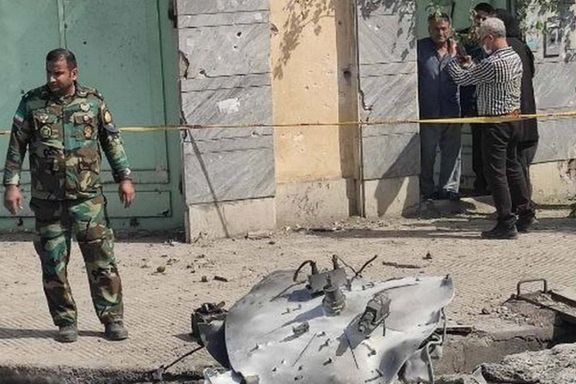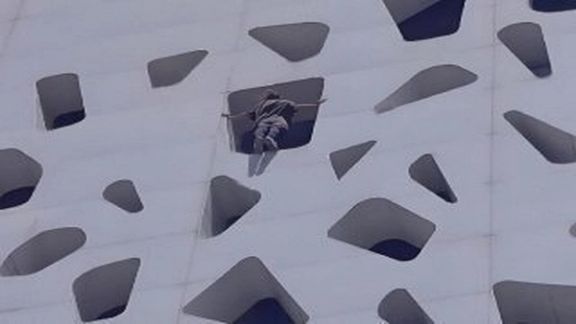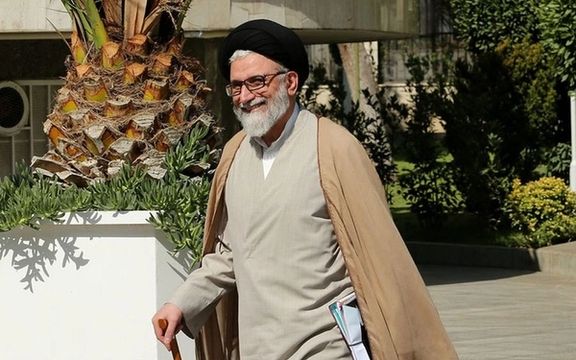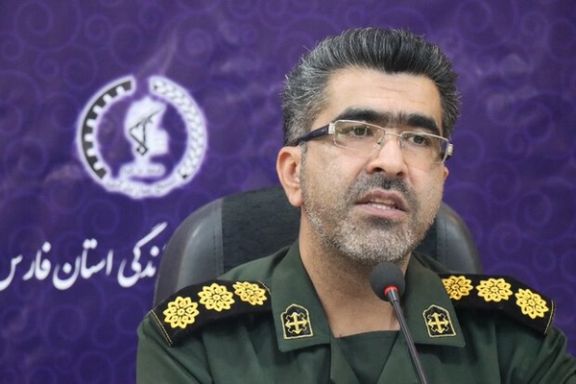Flying Object Crashes, Debris Fall In Iranian City Of Gorgan

Iranian state media reported the crash of a military object in a residential area in the northern city of Gorgan, which the Defense Ministry calls "a malfunction in a military system."

Iranian state media reported the crash of a military object in a residential area in the northern city of Gorgan, which the Defense Ministry calls "a malfunction in a military system."
Defense Ministry spokesperson said Monday, "In the process of testing defense and drone systems in a desert region, one of these systems suffered a technical defect and deviated from its main path."
He confirmed that debris fell in and around the city of Gorgan. No casualties have been reported, but several residential buildings have been damaged, according to videos sent to Iran International.
Various Iranian news outlets have disseminated photographs and videos showing a charred object on a street. The incident has also resulted in damage to nearby shops and vehicles, including shattered windows. In response, the local police have established a secure perimeter around the affected area.
Chief of Police for Golestan province, Mohammad Saeed Fazel Dadgar, claimed in an interview with the semi-official Tasnim news agency that the situation is under control. He additionally noted that some debris from the object had fallen in various parts of the city.
Furthermore, the IRNA state news agency reported that "the sound of the explosion resulting from the drone's impact resonated throughout the entire city."
In February, Iran attributed a drone attack on a military workshop in its central city of Esfahan to Israel. Israel has conducted a series of strikes targeting Iran's nuclear program and other facilities since the collapse of Tehran's 2015 nuclear agreement with the West, marking a protracted covert conflict between the two Middle Eastern adversaries.
While Israeli authorities seldom confirm actions undertaken by the nation's covert military units or its Mossad intelligence agency, Israeli Prime Minister Benjamin Netanyahu has consistently regarded Iran as the most significant threat to his country's security.

Latest statistics suggest a rise in depression in Iran, particularly among women and young people.
The report by the reformist newspaper Ham-Mihan states that out of every five prescriptions issued, one is for antidepressants or sleep-inducing medications.
The report also links the mental health of Iranians to social issues, including protests.
Following the recent uprisings, numerous experts, including university professors, mental health specialists, and sociologists, expressed concerns about the state of Iran's society. Four mental health associations also voiced their concerns about the mental well-being of citizens in a statement.
The newspaper emphasizes that since last year, many individuals have been contemplating migration as a way out of their current situation.
Earlier this year, Saeed Moeedfar, the president of the Sociological Association, warned that Iran is on the brink of a "severe wave of migration" and described a "terrifying despair" gripping society, particularly its youth and intellectuals.
These predictions of an impending massive migration wave come at a time when estimates suggest that roughly one-tenth of the country's population, equivalent to 8.5 million Iranians, currently live abroad as migrants.
Ham-Mihan, citing mental health experts, notes that anxiety and depression, as two of the most prominent psychological disorders, have manifested in various forms in the past year, including an increased desire to migrate, alcohol consumption, substance abuse, and suicide.

In spite of evidence to the contrary, Iran continues to deny its provision of drones to Russia for its war on Ukraine.
Foreign minister Hossein Amir-Abdollahian said the claims by nations worldwide are "completely baseless', in spite of multiple nations globally issuing sanctions on Iran based on its support of its war on Ukraine.
In a conversation with the Arabic-language newspaper Al-Wefaq published in Tehran, he referred to his recent phone call with the EU's foreign policy chief, Josep Borrell, during which Borrell warned about Russia's use of Iranian drones in the conflict with Ukraine.
Throughout the 18-month Russian attack on Ukraine, both Kiev and US officials repeatedly warned about Iran's military support to Moscow, including the delivery of Iranian-made drones.
However, Amir-Abdollahian stated, "Our stance on the Ukraine issue is entirely clear and transparent, and we have no affiliation with any party in our foreign policy."
On September 3rd, the Ukrainian Air Force reported shooting down 26 Iranian-made combat drones, Shahed-131 and Shahed-136, that Russia had deployed in its assault on southern Odessa.
David Barnea, the Director of Mossad, also expressed Israel's concern last week over Russia selling advanced weaponry to Iran in exchange for Iranian-made drones and other equipment, which could potentially jeopardize security.
The United States, the United Kingdom, the European Union, Australia, and New Zealand have all imposed multiple rounds of sanctions on the Islamic Republic due to its alleged provision of drones to Russia in the Ukraine conflict.

Iran’s Intelligence Minister has reiterated threats against Iran International media network "wherever and whenever deemed necessary."
During a television program on state television, Esmail Khatib said the Iranian government would take action against the network throughout the globe, emphasizing that the Islamic Republic would not refrain from invasive measures against the workers of the channel.
He stated, "Support from various countries will not deter us from taking invasive security measures," claiming that several foreign-based channels have promoted “terrorism,” and Iran International is one of the most important ones.
“We believe that Iran International is a terrorist network, and naturally we deem it our duty and mission to act against them wherever and whenever we deem appropriate,” he said, warning that “no terrorist media will be safe.”

Following a significant escalation in state-backed threats from Iran and advice from the London Metropolitan Police, Iran International TV announced in February that it reluctantly and temporarily closed its London studios and moved broadcasting to Washington DC.
Iran International was warned by authorities in November that its journalists were under threat from Iranian agents and the police took measures to strengthen security around the network’s offices.
The channel's broadcasts have gained special significance since popular anti-regime protests broke out in Iran last September. Iranian officials have repeatedly threatened Iran International and other Persian broadcasters based abroad as the government blocked the Internet to deny the population news and information.
Mahmood Enayat, General Manager of Iran International TV, said in February, "A foreign state has caused such a significant threat to the British public on British soil that we have to move. Let’s be clear this is not just a threat to our TV station but the British Public at large. Even more this is an assault on the values of sovereignty, security and free speech that the UK has always held dear... We refuse to be silenced by these cowardly threats. We will continue to broadcast. We are undeterred.”

The Iranian regime has blamed foreign-based Persian broadcasters such as BBC Persian and Iran International for “fomenting unrest”, while all media in the country are under tight government control and present protesters as “rioters” and “terrorists”.
The US Department of State, Belgium-based International Federation of Journalists, and Australia’s Media, Entertainment and Arts Alliance are among entities that expressed support for Iran International and stressed the importance of safeguarding journalists' security and press freedom following the relocation of Iran International’s London office.
Regime authorities, including several Revolutionary Guard commanders, have repeatedly issued threats against Iran International and other foreign-based media outlets.
Following the relocation, IRGC Commander-In-Chief Major General Hossein Salami said the threats against the channel’s journalists "show how far the Islamic Revolution's realm of power, field of infiltration and radius of influence has extended."
Amid repeated threats by the Islamic Republic against Iran International’s reporters, the UK government vowed in December to step up protection of London-based Iranian journalists.
British officials also expressed strong support for Iran International. Tom Tugendhat, the UK's Minister of State for Security, has repeatedly condemned Iran's threats against the network. He affirmed that the UK would continue its support for the network, ensuring its activities in a secure environment.
Vowing to step up protection of London-based Iranian journalists, British Foreign Minister James Cleverly said during a session in Parliament in December that the Foreign and Commonwealth Development Office (FCDO), in partnership with the Home Office, had ensured that the Iranian journalists were protected by the British police.
“The UK remains absolutely determined to ensure that Iran does not intimidate people within this country. We will always stand up to the aggression from foreign nations,” he noted, adding, “We will absolutely not tolerate threats, particularly towards journalists who are highlighting what is going on in Iran, or indeed any other individual living in the UK.”
A man was arrested in the vicinity of Iran International’s headquarters in February and charged with a terrorism offence.
In May, Britain’s shadow security minister slammed the threats against journalists covering Iran’s protests. Speaking on World Press Freedom Day, Holly Lynch, the Labour MP for Halifax, said the threats by the Iranian regime include “assassination and kidnap plots against UK residents who are perceived as enemies of Iran owing to their coverage of the protests and the regime’s brutal crackdown”.
The head of Counter Terrorism Policing (CTP), Assistant Commissioner Matt Jukes in London said in February that “At its sharpest, this has involved police and MI5 working together to foil 15 plots since the start of 2022 to either kidnap or even kill British or UK-based individuals perceived as enemies of the regime,” he said.
Despite ongoing threats, Iran International will soon inaugurate a new building in London.

Almost one year since his death, the family of Ali Seyedi still mourns their young hero who died at the hands of Iranian regime's security forces.
The clashes between several young female protesters and the plainclothes security agents in the city of Parand near Tehran were what prompted Ali to rush into their defense. Alas, little he knew that his not-to-be forgotten act of bravery would cost his own life.
Ali Seyedi had just celebrated his 25th birthday when Mahsa Amini, the young Kurdish woman who has emerged as a new symbol of Iranian women’s resistance against the theocratic dictatorship, passed away in hospital on September 16, 2022, due to the wounds inflicted upon her in police custody.
Mahsa’s death shook Ali to the core like hundreds of thousands of others all over Iran. He promptly joined the wave of protests and commenced posting anti-government content on his Instagram account.
However, this was not adequate to quell the flames of anger in Ali’s soul and quench the thirst for change simmering in his heart. Despite, the imminent danger he was well-acquainted with, Ali joined the ranks of thousands of other protesters who poured into the streets across Iran on October 26, 2022, which marked the 40th day after Mahsa’s death.
“Ali saved the girls, but the plainclothes forces shot him in the torso at close range, then dragged his wounded and bleeding body to the side of the street. A few hours later, when they saw that he was in critical condition, they abandoned him and left the scene,” Zhila Khakpour, Ali's mother recounted.

It took the Seyedis hours to finally find a lead about Ali’s whereabout. The police contacted the family around 5 AM the next day, only to inform them of Ali’s devastating death. Consequently, the backbreaking pressure from the authorities on the family for denying the fact that Ali was shot by the government forces and during a bloody day protest commenced. From menacing threats about not returning Ali’s corpse to his family, to depriving his parents from holding a public funeral for their son and arresting his brother and several of his friends at the cemetery where his tomb is situated, the regime knew no boundary. To this day, the Seyedi family continues to face ongoing pressure to keep them silent.
This has not been an isolated incident confined to the Seyedis. Over the past year, it has been the path that many grieving families have walked. These families lost their wives, husbands, daughters, sons, brothers, and sisters to the brutal crackdown on the widespread anti-regime protests in Iran last year. This trajectory has been especially common among those seeking justice for their loved ones who unjustly perished.
Until now, no one in the upper echelons of the autocratic regime has even remotely acknowledged any responsibility for the ruthless suppression of the protesters.
Reverting to its previous pattern of escalating suppression when confronted with demands for accountability and justice as the first anniversary of Mahsa Amini's death approaches, marking the initiation of what many Iranians now call the "Woman, Life, Freedom" movement, the regime has once more turned to its well-worn strategy of issuing threats and spreading fear among the grieving families.
Mahmood Amiry-Moghaddam, a Norwegian-Iranian human rights advocate and the director of the NGO "Iran Human Rights," has observed a significant increase in the persecution and prosecution of the victims' families. This surge can be directly attributed to the growing influence of the "Movement for Justice Seeking" for the victims of the regime in Iran, led by these families.
Furthermore, resorting to harassment of the protest victims’ families or anyone who can raise their voice, is closely related to the existential threat that the Iranian regime has faced following the outbreak of protests at Mahsa’s death, according to Amiry-Moghaddam. He added that the regime's tactics of intimidation and suppression are attempts to extend its longevity. The human rights advocate, however, deemed that fearmongering and suppression “might temporarily save a dictatorship, but sooner or later they would lose their control over the people again as such regimes lack stability.”
When evaluating the strategies employed by regimes that constantly fear facing the anger of their citizens, one of the most common approaches is to take preemptive measures to silence all dissenting voices. Consequently, in recent weeks, numerous outspoken members of grieving families who have either actively engaged on various social media platforms or maintained contact with other families, channeling their mourning into various forms of protest, have been summoned or arrested by regime forces.
The Iranian authorities have not disclosed the exact number of those arrested, nor have they provided reasons for their detention. In certain cases, they have even arrested lawyers who were representing these individuals, seemingly attempting to hinder the sharing of information regarding the families' status.
Moein Khazaeli, a journalist and human rights researcher based in Sweden, has suggested that the relentless crackdown by the Iranian regime's intelligence apparatus is motivated by their realization that "the justice-seeking families of the victims have become the face of the Woman, Life, Freedom movement in Iran." Consequently, the regime has prioritized suppressing these families by intensifying pressure on them, aiming to erase the identity of the protest movement and silence its voice, at least temporarily.
Sources familiar with the situation have informed Iran International that the authorities' main goal is to compel the arrested individuals into a vow of silence. This entails refraining from organizing anniversary ceremonies in memory of their loved ones and avoiding posting any calls for protests on social media.
The same fate befell some outspoken families of the protesters killed in what is commonly referred to as the “Bloody November” back in 2019 when mass protest rallies across Iran over the rising fuel price, soon turned into a call for toppling of the regime and received a violent reaction from Iran’s clerical establishment.
Reuters news agency reported in December 2019 that about 1,500 people were killed during less than two weeks of unrest including at least 17 teenagers and about 400 women.
Highlighting a similarity between the events of Bloody November and the Woman, Life, Freedom protests in Iran, Amiry-Mohghaddam pointed out that the efforts of the families of the 2019 crackdown victims have played a crucial role in reshaping the face of the Movement for Justice Seeking in Iran and attracting more international attention and recognition. As a result, the Iranian regime has sought to escalate its endeavors to restrain any actions by the families in ht elatest round of protests who are actively seeking accountability and justice for their deceased loved ones.
As the first anniversary of the Woman, Life, Freedom protest movement approached, the bold call for justice once again rose stronger and more determined than ever before. It stands as a precursor to the eventual downfall of a tyrannical regime that has consistently disregarded the needs and aspirations of its people. The departed have arisen to confront their oppressors and carry on their quest for justice.
“My son was a hero; he saved his fellow countrywomen. However, I always regret that he left without saying goodbye. We have not yet revealed the extent of the pressure that they (the Iranian regime) have exerted upon us; what I have recounted is merely part of the harassment we suffered,” said Ali’s sorrowful mother. She can only hold onto hope for a memorial ceremony on the first anniversary of her son's passing to ensure his name remains a part of the history of the freedom-seeking movement in Iran.
(This is an article by Maryam Moqaddam and Masoud Kazemi, journalists at Iran International)

Gunfire by two unidentified assailants in Iran's Fars province on Saturday led to the death of one Basij member and injuries to three others.
Esmail Qezel-Sofla, the deputy for political and security affairs of Fars Province Governor Office, provided details of the attack, stating, "The assailants strategically positioned themselves in the southern vicinity of the Nurabad Mamasani and employed hunting rifles to carry out their assault. The victims sustained injuries from the chest upwards, and the perpetrators swiftly fled the scene following the attack."
Intelligence, security, and law enforcement agencies have launched an intensive operation to identify and apprehend the suspects, as stated by Qezel-Sofla who said one of the injured victims has been transported to a hospital in Shiraz, while the remaining two are currently receiving medical treatment at local healthcare facilities. The victims, he said, are "stable".
The armed attack occurs in the midst of a series of attacks targeting military and paramilitary forces in various cities across Iran, against the backdrop of ongoing protests in recent months. The protests emerged in response to the death of Mahsa Amini while in morality police custody and the subsequent suppression of demonstrators. Such attacks have been directed at military personnel, law enforcement officers, and even clerics.






